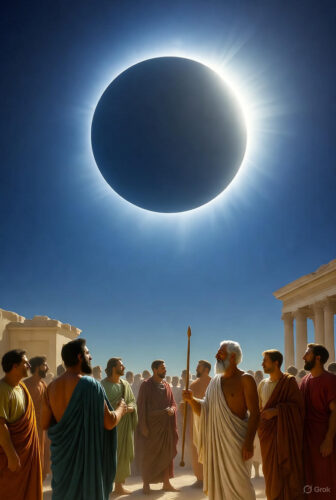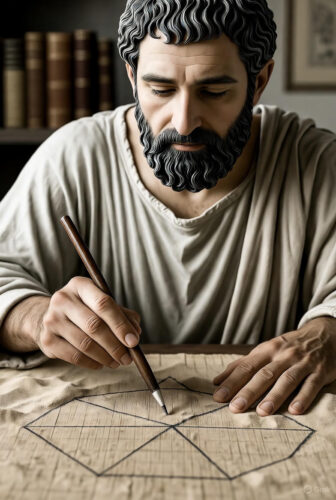Picture this: the bustling port city of Alexandria in the year 320 AD, where the Mediterranean sea laps against ancient quays, and the air is thick with the scent of papyrus scrolls and scholarly debates. On October 18 of that year, the sun dimmed in the sky, casting an eerie twilight over the rooftops and temples. Amid this cosmic spectacle stood Pappus of Alexandria, a mathematician whose keen eyes and sharper mind captured the moment, weaving it into his commentaries on the stars. This wasn’t just an astronomical footnote; it was a pivotal observation that anchored Pappus’s era in history, preserving the flame of Greek mathematical tradition during the twilight of antiquity. In this blog, we’ll embark on a thrilling journey through Pappus’s life, his groundbreaking works, the context of his eclipse observation, and the vast tapestry of Hellenistic science he helped safeguard. Packed with historical depth and a dash of adventure, this tale will educate and entertain, before wrapping up with motivational gems on how this ancient insight can supercharge your modern life.
To grasp the significance of Pappus’s eclipse sighting, we must first delve into the man himself. Pappus flourished in the early 4th century AD, a time when the Roman Empire was transitioning under Constantine the Great, who would soon make Christianity the favored religion. Born around 290 AD in Alexandria—Egypt’s intellectual powerhouse—Pappus emerged as one of the last great geometers of the ancient world. Little is known about his personal life; no dramatic biographies survive, unlike those of Euclid or Archimedes. What we do know comes from his own writings and later references, such as in the Suda Lexicon, a 10th-century Byzantine encyclopedia that lists him as a philosopher and mathematician. He likely taught at a school or academy in Alexandria, perhaps a successor to the famed Mouseion, where scholars like Euclid had once pondered the universe.
Alexandria in Pappus’s time was a melting pot of cultures: Greek, Egyptian, Roman, Jewish, and emerging Christian influences. Founded by Alexander the Great in 331 BC, it boasted the Great Library, though much diminished by fires and neglect by the 4th century. The Pharos Lighthouse still guided ships, and the Serapeum temple doubled as a center for learning. Pappus operated in this environment, where pagan traditions clashed with rising monotheism. Emperor Diocletian’s persecutions (303-311 AD) had targeted Christians, but by 320, Constantine’s Edict of Milan (313) promoted tolerance. Amid these shifts, Pappus focused on preserving mathematical knowledge, acting as a bridge between classical Greece and the medieval world.
His magnum opus, the “Synagoge” or “Mathematical Collection,” is an eight-book compendium that survives partially today. Written in Greek, it wasn’t an original treatise but a masterful synthesis of prior works, many now lost. Pappus aimed to revive interest in geometry, which had waned since Apollonius of Perga (c. 240-190 BC). Book I is missing, but Books II through VIII cover arithmetic, geometry, mechanics, astronomy, and more. In Book II, he discusses mean proportionals and large numbers, introducing a system for expressing numbers up to 10^16—a precursor to modern exponentiation. He credits Apollonius for a method of multiplying large numbers, illustrating with examples like the grains of sand in the universe, echoing Archimedes’ “Sand Reckoner.”
Book III delves into geometric problems, including duplicating the cube and trisecting angles—classic unsolvable puzzles with straightedge and compass. Pappus classifies problems into plane (solvable with lines and circles), solid (requiring conics), and linear (needing higher curves). This classification influenced later mathematicians like Descartes. He also explores paradoxes, like the curve of constant width, predating the Reuleaux triangle.
Books IV and V are geometric treasures. Book IV examines spirals, quadrilaterals, and the quadratrix curve for squaring the circle. Pappus proves properties of the Archimedean spiral and introduces the “Pappus chain” of circles. Book V focuses on isoperimetric problems: figures with equal perimeters enclosing maximum areas. He praises the sphere as nature’s most perfect shape, citing bees’ honeycombs as hexagonal prisms for efficiency—a nod to biology in math. Drawing from Zenodorus (c. 200 BC), Pappus shows the circle encloses the most area among plane figures, extending this to 3D.
Astronomy shines in Book VI, commenting on minor astronomical works like Theodosius’s “Sphaerica” and Autolycus’s treatises on spheres. Pappus clarifies spherical geometry for sundials and planetary motions, crucial for Ptolemaic models. Here, he mentions the solar eclipse of October 18, 320 AD, using it to date his work on Ptolemy’s “Almagest.” The “Almagest,” Ptolemy’s 2nd-century masterpiece, detailed geocentric cosmology with epicycles. Pappus’s commentary on Books V and VI survives, where he describes the eclipse occurring in the month Tybi of the Egyptian calendar, corresponding to October 18. He notes its partial nature in Alexandria, using it to verify lunar parallax calculations.
This observation wasn’t mere stargazing; it was scientific rigor. Eclipses helped refine astronomical tables, predicting celestial events for navigation, agriculture, and astrology. In 320 AD, the eclipse was annular or partial in Alexandria, with the moon covering much of the sun. Pappus likely used instruments like the astrolabe or dioptra to measure angles. His record fixed his chronology, as historians like A. Rome later confirmed the date via astronomical back-calculation.
Book VII, the “Treasury of Analysis,” is Pappus’s crown jewel for modern geometry. It summarizes lost works by Euclid, Apollonius, and Aristaeus, listing 33 lemmas for analytic methods—solving problems via assumed constructions. Here lies Pappus’s hexagon theorem: In a projective plane, if points A,B,C are on one line and D,E,F on another, then intersections of AD-BE, AE-CF, and AF-BD are collinear. This theorem, rediscovered in the 17th century, underpins projective geometry, influencing Pascal and Desargues. Pappus used it to prove properties of conics, preserving Apollonius’s ideas.
Book VIII covers mechanics, including centers of gravity and inclined planes. Pappus’s centroid theorem states that the volume (or area) of a solid (or plane) of revolution is the product of the generating figure’s area (or length) and the distance traveled by its centroid. This anticipates integral calculus, used today in engineering for moments of inertia.
Pappus’s influence extended beyond his books. He commented on Euclid’s “Elements,” clarifying porisms (corollaries). His work on music theory in Book III linked ratios to harmonics, echoing Pythagoras. In geography, he contributed to map projections, influencing later cartographers.
The eclipse context: Solar eclipses were omens in antiquity. The 320 AD event, visible across the Mediterranean, might have stirred superstitions amid Christian-pagan tensions. Constantine’s vision at Milvian Bridge (312 AD) involved a solar symbol, the Chi-Rho. Pappus, likely pagan, viewed it scientifically, aligning with Alexandria’s rational tradition from Eratosthenes (who measured Earth’s circumference) to Hypatia (murdered in 415 AD).
Alexandria’s scholarly decline loomed. The Library’s destruction (multiple events: Caesar’s fire 48 BC, Aurelian’s sack 273 AD, Theophilus’s decree 391 AD) scattered knowledge. Pappus’s “Collection” saved fragments, transmitted via Byzantium and Arabs. Translated into Arabic by 9th-century scholars like Thabit ibn Qurra, it reached Europe via Latin versions by Commandino (1588).
Pappus’s era saw math evolve. Diophantus (c. 250 AD) advanced algebra; Theon of Alexandria (Hypatia’s father) edited Euclid. Pappus bridged geometry and analysis, foreshadowing coordinate geometry.
Diving deeper: In Book VII, Pappus discusses the “locus to three or four lines,” a curve (Cartesian parabola) generated by ratios of distances. This inspired Descartes’s “Geometry” (1637), founding analytic geometry.
His mechanical insights: Book VIII describes gears and screws, applying geometry to machines like the Archimedean screw for irrigation—vital in Nile-dependent Egypt.
Astronomically, Pappus refined Ptolemy’s lunar model, calculating epicycle radii using eclipse data. The 320 eclipse helped calibrate anomalies in lunar motion.
Culturally, Pappus embodied the “silver age” of Greek math—innovative synthesis rather than pure creation. Unlike Euclid’s axioms, Pappus emphasized problem-solving methods.
His legacy: Rediscovered in Renaissance, influencing Viete, Kepler, Newton. Kepler used Pappus’s conic properties for elliptical orbits. Newton cited his centroid theorem in “Principia.”
Today, Pappus’s theorems thrive in computer graphics, robotics, and physics. Hexagon theorem aids computer vision; centroid in structural engineering.
Pappus’s Alexandria buzzed with innovation. The Mouseion, funded by Ptolemies, housed scholars. By 320, it waned, but private academies persisted. Pappus likely collaborated with astronomers, using the Canopic Way observatories.
The eclipse: Astronomical software confirms a partial solar eclipse on October 18, 320 AD, visible in Alexandria around midday, with 80-90% obscuration. Pappus recorded it in his “Almagest” commentary, noting timing for parallax—difference in apparent position from different locations.
This method built on Hipparchus (c. 150 BC), who used eclipses for lunar distance. Pappus’s data refined it, aiding longitude calculations.
Post-Pappus, math migrated east. Hypatia continued geometry until her death; then, Byzantine scholars like Proclus (5th century) commented on Euclid.
Arab golden age: Al-Khwarizmi (9th century) drew from Pappus; Omar Khayyam solved cubics using conics Pappus preserved.
European revival: Fibonacci (13th century) echoed his arithmetic; Regiomontanus (15th century) translated his works.
Modern applications: In CAD software, Pappus’s chains model gear systems; in optimization, isoperimetric problems solve minimal surfaces.
Pappus’s style: Witty and pedagogical, he posed challenges like “Given a rhombus, construct a conchoid…” to engage readers.
Controversies: Some attribute originality to him unduly; he credited sources, but losses make assessment hard.
His death around 350 AD marked an end; no major geometers followed until the Renaissance.
This eclipse observation encapsulates perseverance: In declining times, Pappus documented, ensuring knowledge’s survival.
Now, the motivational pivot: Pappus’s act of observing and recording amid uncertainty teaches us to capture moments of insight, turning fleeting events into lasting wisdom. In today’s fast-paced world, this fosters curiosity and resilience, benefiting personal growth.
Specific benefits:
– **Cultivate Observational Skills**: Like Pappus noting eclipse details, train yourself to spot opportunities—e.g., in networking, observe body language to build better relationships.
– **Preserve Knowledge Through Documentation**: Pappus saved theorems; journal daily experiences to reflect and learn, turning failures into lessons for career advancement.
– **Bridge Past and Present**: By synthesizing old works, Pappus innovated; apply historical strategies to modern problems, like using ancient stoicism for stress management.
– **Embrace Interdisciplinary Thinking**: His math-astronomy blend; combine hobbies, e.g., art and tech, to spark creative side projects.
– **Persist in Adversity**: Amid Alexandria’s decline, he worked; during personal lows, maintain routines like exercise to build momentum.
Step-by-step plan:
- **Identify a ‘Eclipse’ Moment**: Pinpoint a current challenge or wonder, like a work puzzle.
- **Observe Deeply**: Gather data—research, note details without judgment.
- **Synthesize Insights**: Connect to past knowledge or experiences.
- **Document and Share**: Write it down, perhaps blog or discuss.
- **Apply and Iterate**: Test in life, refine based on results.
- **Celebrate Preservation**: Reward yourself, reinforcing the habit.
This transforms history into action, igniting your potential.

